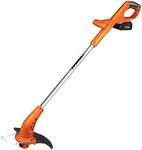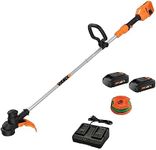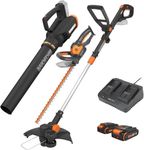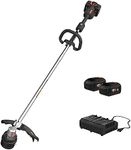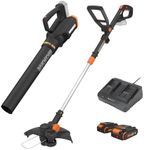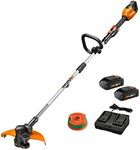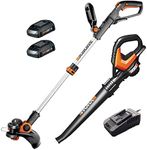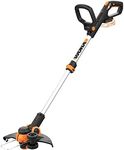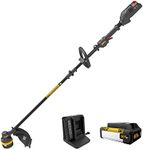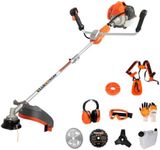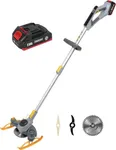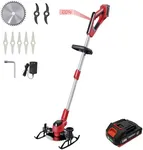Buying Guide for the Best Worx Lawn Trimmers
When choosing a lawn trimmer, it's important to consider several key specifications to ensure you get the best fit for your needs. Lawn trimmers, also known as string trimmers or weed eaters, are essential tools for maintaining a neat and tidy lawn. They help you trim grass and weeds in areas that a lawnmower can't reach, such as around trees, fences, and garden beds. To make an informed decision, you should understand the different features and how they impact the performance and usability of the trimmer.Power SourceThe power source of a lawn trimmer can be either electric (corded or cordless) or gas-powered. Electric trimmers are generally lighter, quieter, and easier to maintain. Corded models offer unlimited runtime but require an extension cord, which can limit mobility. Cordless models provide more freedom of movement but have limited battery life. Gas-powered trimmers are more powerful and suitable for larger areas but are heavier, noisier, and require more maintenance. Choose an electric trimmer for small to medium yards and a gas-powered one for larger properties.
Cutting WidthThe cutting width, or swath, is the diameter of the area the trimmer can cut in a single pass. This spec is important because it affects how quickly you can complete your trimming tasks. Cutting widths typically range from 10 to 18 inches. A smaller cutting width (10-12 inches) is suitable for precision trimming in tight spaces, while a larger cutting width (14-18 inches) is better for covering larger areas more quickly. Consider the size and complexity of your yard when choosing the cutting width.
WeightThe weight of the lawn trimmer is crucial for ease of use and comfort, especially if you have a large area to trim. Lighter trimmers (5-8 pounds) are easier to handle and maneuver, making them ideal for smaller yards or for users who may have difficulty handling heavier equipment. Heavier trimmers (9-15 pounds) may offer more power and durability but can cause fatigue during extended use. Choose a weight that you can comfortably manage for the duration of your trimming tasks.
Line Feed SystemThe line feed system determines how the trimmer line is advanced during use. There are three main types: bump feed, automatic feed, and fixed line. Bump feed systems require you to tap the trimmer head on the ground to release more line, offering control but requiring manual effort. Automatic feed systems release line as needed without user intervention, providing convenience but potentially wasting line. Fixed line systems use pre-cut lengths of line, which are easy to replace but may require more frequent stops. Choose a line feed system based on your preference for control and convenience.
Shaft TypeLawn trimmers come with either a straight or curved shaft. Straight shaft trimmers offer a longer reach and are better for trimming under bushes and around obstacles. They are also more suitable for taller users. Curved shaft trimmers are generally lighter and easier to handle, making them ideal for smaller yards and shorter users. Consider your height and the type of trimming tasks you will be performing when choosing the shaft type.
Adjustable FeaturesAdjustable features, such as telescoping shafts, adjustable handles, and pivoting trimmer heads, enhance the usability and comfort of the trimmer. Telescoping shafts allow you to adjust the length of the trimmer to suit your height, while adjustable handles provide a more comfortable grip. Pivoting trimmer heads enable you to change the angle of the cutting head for better access to hard-to-reach areas. Look for adjustable features that will make the trimmer more comfortable and versatile for your specific needs.


